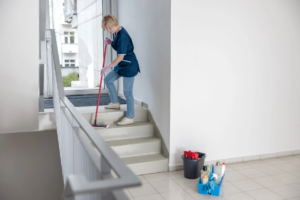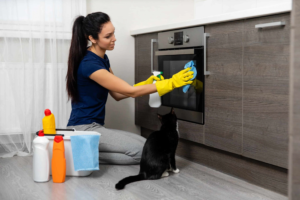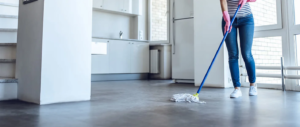[fsn_row][fsn_column width=”12″][fsn_text]
Cork floors offer a unique and eco-friendly flooring option, but regular cleaning is essential to maintain their beauty and longevity. In this detailed guide, we’ll provide a structured approach to how to clean cork floors, ensuring they stay in top-notch condition for years to come.
Cleaning cork floors is a straightforward process involving a few simple steps to maintain natural beauty and durability. Start by regularly sweeping or vacuuming to remove dirt and debris that can scratch the surface. Next, damp mop the floor using a pH-neutral cleaner diluted in water, ensuring it’s not too wet to prevent water damage. Avoid harsh chemicals or excessive moisture, and always dry the floor thoroughly after cleaning to preserve the cork’s integrity. Additionally, consider resealing the cork every few years to protect it and keep it looking its best.
Understanding Cork Flooring
What Are Cork Floors?
Cork floors are a flooring material made from the bark of cork oak trees. Cork is a renewable and eco-friendly resource, as the bark can be harvested without harming the tree, which regenerates the bark over time. The harvested cork is then processed and transformed into cork tiles or planks used as a versatile and sustainable flooring option. Cork floors are known for their natural warmth, softness underfoot, sound-absorbing properties, and unique, visually appealing texture. They are famous for those seeking an environmentally friendly, comfortable flooring solution in homes and commercial spaces.
Advantages of Cork Flooring
Cork flooring offers several advantages that make it a popular choice for homeowners and businesses:
- Eco-Friendly: Cork is a sustainable and renewable resource, as it is harvested from the bark of cork oak trees without causing harm to the tree itself. This eco-friendliness appeals to environmentally conscious consumers.
- Comfort and Insulation: Cork flooring is naturally soft and cushioned, providing a comfortable surface to walk and stand on. It also offers excellent thermal and acoustic insulation, making rooms quieter and more energy-efficient.
- Durability: Cork is a resilient material that can withstand daily wear and tear thanks to its natural resilience and ability to bounce back from pressure. It’s also resistant to moisture, mold, and mildew, making it a durable choice for various areas, including kitchens and bathrooms.
- Aesthetic Appeal: Cork floors come in various styles, colors, and textures, allowing for versatile design options. The natural patterns and textures of cork lend a unique and warm visual appeal to any space.
- Hypoallergenic: Cork is naturally resistant to allergens, making it an excellent choice for those with allergies or respiratory sensitivities, as it doesn’t trap dust or pet dander.
- Easy Maintenance: Cork flooring is relatively low-maintenance, requiring routine sweeping and occasional damp mopping to keep it clean. Many cork floors come pre-finished with protective sealants that enhance longevity and simplify care.
- Sustainability: Choosing cork flooring encourages responsible forest management and supports sustainable agricultural practices, as cork oak trees play a vital role in carbon absorption and soil conservation.
- Resale Value: Homes with cork flooring can have increased resale value due to the appeal of its eco-friendly and comfortable features, making it an attractive investment for homeowners.
Challenges of Cork Flooring
While cork flooring has numerous advantages, it also comes with some challenges:
- Susceptibility to Damage: Despite its resilience, cork flooring can be prone to damage from heavy furniture, sharp objects, or high heels, which may dent or puncture the surface. Careful use of furniture pads and avoiding dragging heavy items can help prevent these issues.
- Moisture Concerns: Although cork is somewhat resistant to moisture, it is not entirely waterproof. Prolonged exposure to moisture or standing water can lead to warping or discoloration. It’s important to promptly address spills and maintain a dry environment in kitchens and bathrooms.
- Fading and Discoloration: Over time, cork flooring may fade or change color when exposed to direct sunlight. To mitigate this, using blinds, curtains, or area rugs to limit sunlight exposure can help preserve the floor’s appearance.
- Maintenance Needs: While cork floors are generally low-maintenance, they require periodic resealing to protect against wear and stains. This additional step is essential to ensure the longevity of the flooring.
- Initial Investment: Cork flooring can be more expensive upfront than other flooring options, but it often pays off in terms of long-term durability and energy efficiency.
- Limited Style Options: While cork comes in various styles and colors, it may not offer as broad a range of design choices as other flooring materials. This limitation can affect its suitability for specific interior aesthetics.
- Vulnerability to Sharp Objects: Sharp or heavy objects can puncture the cork surface, causing damage. Taking precautions like using felt pads under furniture legs and avoiding sharp objects can help prevent this issue.
- Not Ideal for High-Traffic Areas: Cork flooring may show signs of wear in extremely high-traffic areas more quickly. It’s better suited for residential spaces or areas with moderate foot traffic.
Materials and Tools You’ll Need
Before we delve into the cleaning process, gather the following materials and tools:
- Broom or vacuum cleaner
- Soft-bristle brush
- Cork floor cleaner
- Mop
- Microfiber cloth or mop pad
- Warm water
- Mild dish soap
- White vinegar
- Soft, lint-free cloths
- Protective pads for furniture
Routine Maintenance
Sweeping and Vacuuming
Regularly sweeping or vacuuming your cork floors removes dirt and debris that can cause scratches.
Mopping Cork Floors
When mopping cork floors, opt for a gentle approach using a damp, not soaking, soft cloth to avoid moisture damage. Regular mopping helps remove dirt particles and keeps your floors looking their best.
Dealing with Spills and Stains
Address spills promptly on your hardwood floors to prevent stains; blot the area gently with a soft cloth before it penetrates the wood. Quick action minimizes the risk of lasting damage from dirt particles or liquids.
Pet Stains
For pet stains on hardwood floors, immediately clean the area, first blotting the mess with a soft cloth. Then, thoroughly address any remaining dirt particles or odors using appropriate cleaning products to ensure your floors remain in top condition.
Deep Cleaning Cork Floors
When to Deep Clean
Deep cleaning cork floors is recommended when regular maintenance is insufficient to remove embedded dirt stains or when the finish appears worn, typically occurring every 1 to 2 years, depending on foot traffic and usage.
Steps for Deep Cleaning
For deep cleaning cork floors, first, remove loose debris, then apply a cork-specific deep cleaner, agitate with a soft brush, rinse with a damp mop, and finally, ensure thorough drying to rejuvenate and protect the flooring.
Preventive Measures
To prevent damage and maintain the longevity of cork floors, use furniture pads and rugs in high-traffic areas, promptly clean up spills, avoid dragging heavy objects, and regularly reseal the surface as needed.
Furniture Protectors
Using furniture protectors, such as felt pads or coasters under the legs of heavy furniture, is essential to prevent scratches and dents on cork floors, preserving their appearance and integrity.
Restoring and Refinishing Cork Floors
Restoring and refinishing cork floors involves sanding away imperfections, applying a new finish or sealer, and ensuring proper drying to rejuvenate and protect the surface, a process recommended every 5 to 7 years to extend the lifespan of the flooring.
DIY vs. Professional Cleaning
Deciding between DIY and professional cleaning for your cork floors depends on your comfort level, the cleaning required, and the results you seek. While DIY cleaning is cost-effective for routine maintenance, professional cleaning is advisable for deep cleaning, especially if the floor is heavily soiled or requires specialized treatments, as experts have the expertise and equipment to achieve optimal results.
Common Mistakes to Avoid
Common mistakes to avoid with cork floors include neglecting to use furniture pads or protective measures to prevent scratches and dents, using harsh chemicals that can damage the surface, and failing to promptly address spills and moisture, as cork is sensitive to water. Additionally, not resealing the cork as needed, using improper cleaning techniques, or dragging heavy furniture across the surface can lead to premature wear and damage.
Benefits of Well-Maintained Cork Floors
Well-maintained cork flooring offers a plethora of benefits that extend beyond the surface, making it a preferred choice for homeowners. One of the most significant advantages lies in its eco-friendly nature, providing a sustainable and renewable flooring option. Additionally, properly maintained cork floors are not only visually appealing but also known for their durability and natural insulation properties, contributing to energy efficiency within your living space. The longevity of cork flooring can be further enhanced through regular cleaning and maintenance, reducing the need for deeper cleaning or the involvement of cleaning professionals. The careful care of this eco-conscious material ensures that your hardwood flooring remains in pristine condition, minimizing the risk of damage and preserving its charm for years to come.
Conclusion
Cork floors provide a beautiful and sustainable flooring option, but they require proper care. By following the guidelines in this comprehensive guide, you can enjoy your cork floors’ natural beauty for years to come.
Tired of struggling with stubborn stains and dirt on your cork floors? Let Pro Clean take the burden off your shoulders. Our specialized house cleaning maid service North Vancouver techniques will make your floors shine and extend their lifespan. It’s time to embrace clean and healthy cork floors; contact us now!
Do you have hardwood floors? Learn “how to clean prefinished hardwood floors” with ease. Click for a step-by-step guide and enjoy the beauty of your floors for years to come!”
FAQs: How to Clean Cork Floors?
How often should I clean my cork floors?
Regular sweeping and periodic mopping are essential. Deep cleaning should be done as needed.
Can I use regular cleaning products on cork floors?
Using a cork floor cleaner or a mixture of warm water and mild dish soap is recommended.
Are cork floors suitable for kitchens and bathrooms?
Yes, but you should take extra precautions to prevent moisture damage.
How can I remove stubborn stains from cork floors?
You can use a mixture of white vinegar and warm water to help remove stains.
Is it necessary to hire a professional for cork floor cleaning?
While you can clean cork floors yourself, hiring a professional is advisable for deep cleaning and refinishing.
[/fsn_text][/fsn_column][/fsn_row]





